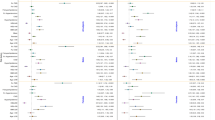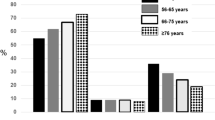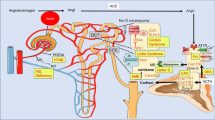Abstract
A genome-wide approach found significant association of two at-risk haplotypes (HapA, HapB) in the ALOX5AP gene with myocardial infarction and stroke. To date, it is still controversial whether ALOX5AP gene polymorphisms are risk factors for stroke. The aim of the present study is to investigate the association between the ALOX5AP gene polymorphism and the risk for stroke in Eastern Chinese Han population with a haplotype-based analysis. We conducted a comprehensive association study of 507 stroke patients and 510 healthy controls to assess the association between the ALOX5AP tagging single-nucleotide polymorphisms (tSNPs) and stroke risk. Genotyping was performed using the PCR–RFLP assay. In the single-locus analysis, we found that the rs9579646 AG genotype was associated with a marginally decreased risk for stroke (adjusted odds ratio, 0.65; 95% confidence interval, 0.45–0.96), compared with the AA genotype. Haplotype-based association analysis of block 2 involving rs10507391 and rs12429692 revealed that the decreased risk of stroke was significantly associated with haplotype AA (OR, 0.66; 95% CI, 0.46–0.95). These results suggested that the genetic variants in ALOX5AP might modulate the risk of stroke in Eastern Chinese Han population. The frequencies of single-marker alleles and haplotypes showed remarkable differences from those in other populations.


Similar content being viewed by others
Abbreviations
- ALOX5AP/FLAP:
-
5-lipoxygenase activating protein
- ALOX5:
-
5-lipoxygenase
- BMI:
-
Body mass index
- CAD:
-
Coronary artery disease
- CI:
-
Confidence intervals
- CT:
-
Computed tomography
- CVD:
-
Cerebrovascular disease
- DM:
-
Diabetes mellitus
- HDL-C:
-
High density lipoprotein cholesterol
- LD:
-
Linkage disequilibrium
- MAF:
-
Minor allele frequency
- MRI:
-
Magnetic resonance imaging
- OR:
-
Odds ratios
- PCR:
-
Polymerase chain reaction
- RFLP:
-
Restriction fragment length polymorphism
- SNPs:
-
Single-nucleotide polymorphisms
- tSNPs:
-
Tagging single-nucleotide polymorphisms
- TC:
-
Total cholesterol
- TG:
-
Triglycerides
References
Liu M, Wu B, Wang WZ, Lee LM, Zhang SH, Kong LZ (2007) Stroke in China: epidemiology, prevention, and management strategies. Lancet Neurol 6:456–464
Flossmann E, Schulz UG, Rothwell PM (2004) Systematic review of methods and results of studies of the genetic epidemiology of ischemic stroke. Stroke 35:212–227
Liu F, He Z, Deng S, Zhang H, Li N, Xu J (2010) Association of adiponectin gene polymorphisms with the risk of ischemic stroke in a Chinese Han population. Mol Biol Rep (in press)
Libby P (2002) Inflammation in atherosclerosis. Nature 420:868–874
Crosslin DR, Shah SH, Nelson SC et al (2009) Genetic effects in the leukotriene biosynthesis pathway and association with atherosclerosis. Hum Genet 125:217–229
Jala VR, Haribabu B (2004) Leukotrienes and atherosclerosis: new roles for old mediators. Trends Immunol 25:315–322
Dixon RA, Diehl RE, Opas E et al (1990) Requirement of a 5-lipoxygenase-activating protein for leukotriene synthesis. Nature 343:282–284
Helgadottir A, Manolescu A, Thorleifsson G et al (2004) The gene encoding 5-lipoxygenase activating protein confers risk of myocardial infarction and stroke. Nat Genet Mar 36:233–239
Helgadottir A, Gretarsdottir S, St Clair D et al (2005) Association between the gene encoding 5-lipoxygenase-activating protein and stroke replicated in a Scottish population. Am J Hum Genet 76:505–509
Lohmussaar E, Gschwendtner A, Mueller JC et al (2005) ALOX5AP gene and the PDE4D gene in a central European population of stroke patients. Stroke 36:731–736
Kajimoto K, Shioji K, Ishida C et al (2005) Validation of the association between the gene encoding 5-lipoxygenase-activating protein and myocardial infarction in a Japanese population. Circ J 69:1029–1034
Meschia JF, Brott TG, Brown RD Jr et al (2005) Phosphodiesterase 4D and 5-lipoxygenase activating protein in ischemic stroke. Ann Neurol 58:351–361
Kaushal R, Pal P, Alwell K et al (2007) Association of ALOX5AP with ischemic stroke: a population-based case-control study. Hum Genet 121:601–607
Zhang WL, Yang XM, Shi J, Sun K, Hui RT (2006) Polymorphism of SG13S114T/A in the ALOX5AP gene and the risk for stroke in a large Chinese cohort. Yi Chuan Xue Bao 33:678–684
Zee RY, Cheng S, Hegener HH, Erlich HA, Ridker PM (2006) Genetic variants of arachidonate 5-lipoxygenase-activating protein, and risk of incident myocardial infarction and ischemic stroke: a nested case-control approach. Stroke 37:2007–2011
Koch W, Hoppmann P, Mueller JC, Schomig A, Kastrati A (2007) No association of polymorphisms in the gene encoding 5-lipoxygenase-activating protein and myocardial infarction in a large central European population. Genet Med 9:123–129
Clark AG (2004) The role of haplotypes in candidate gene studies. Genet Epidemiol 27:321–333
Carlson CS, Eberle MA, Rieder MJ, Yi Q, Kruglyak L, Nickerson DA (2004) Selecting a maximally informative set of single-nucleotide polymorphisms for association analyses using linkage disequilibrium. Am J Hum Genet 74:106–120
Hinds DA, Stuve LL, Nilsen GB et al (2005) Whole-genome patterns of common DNA variation in three human populations. Science 307:1072–1079
Li Z, Sun L, Zhang H et al (2003) Elevated plasma homocysteine was associated with hemorrhagic and ischemic stroke, but methylenetetrahydrofolate reductase gene C677T polymorphism was a risk factor for thrombotic stroke: a multicenter case-control study in China. Stroke 34:2085–2090
Kelly TN, Gu D, Chen J et al (2008) Cigarette smoking and risk of stroke in the Chinese adult population. Stroke 39:1688–1693
Barrett JC, Fry B, Maller J, Daly MJ (2005) Haploview: analysis and visualization of LD and haplotype maps. Bioinformatics 21:263–265
Schaid DJ, Rowland CM, Tines DE, Jacobson RM, Poland GA (2002) Score tests for association between traits and haplotypes when linkage phase is ambiguous. Am J Hum Genet 70:425–434
Stephens M, Donnelly P (2003) A comparison of Bayesian methods for haplotype reconstruction from population genotype data. Am J Hum Genet 73:1162–1169
Zintzaras E, Rodopoulou P, Sakellaridis N (2009) Variants of the arachidonate 5-lipoxygenase-activating protein (ALOX5AP) gene and risk of stroke: a HuGE gene-disease association review and meta-analysis. Am J Epidemiol 169:523–532
Wang B, Zhao H, Zhou L et al (2009) Association of genetic variation in apolipoprotein E and low density lipoprotein receptor with ischemic stroke in Northern Han Chinese. J Neurol Sci 276:118–122
Chen J, Zheng H, Bei JX et al (2009) Genetic structure of the Han Chinese population revealed by genome-wide SNP variation. Am J Hum Genet 85:775–785
Acknowledgments
This work was supported by Natural Science Foundation of Jiangsu Province (No. BS2006007) and Research Fundation of Jiangsu Province Hygiene Committee (No.H201005). We sincerely thank Chunye Luan, Xiaolei Gu and Shuang Lou for their assistance in recruiting the subjects; Cheng Chen, Juan Wu for their technical support; Guangfu Jin and Chenbo Ji for their laboratory assistance; Guixiang Ji and Xinliang Ding for assistance in data analysis.
Author information
Authors and Affiliations
Corresponding authors
Additional information
Hao Sun and Hao Wu contributed equally.
Electronic supplementary material
Below is the link to the electronic supplementary material.
Rights and permissions
About this article
Cite this article
Sun, H., Wu, H., Zhang, J. et al. A tagging SNP in ALOX5AP and risk of stroke: a haplotype-based analysis among eastern Chinese Han population. Mol Biol Rep 38, 4731–4738 (2011). https://doi.org/10.1007/s11033-010-0610-4
Received:
Accepted:
Published:
Issue Date:
DOI: https://doi.org/10.1007/s11033-010-0610-4




